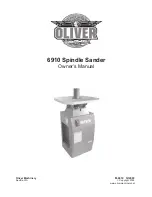
4
Oliver Machine
ry
Seattle,
WA |
Copyright 2005 | www.olivermachinery.net
•
USE RECOMMENDED ACCESSORIES.
The use of accessories and attachments not recommended by
OLIVER may cause hazards or risk of injury to persons.
•
NEVER STAND ON A MACHINE.
Serious injury could occur if the machine is tipped.
•
CHECK DAMAGED PARTS.
Before further use of the machine, a guard or other part that is damaged should
be carefully checked to determine that it will operate properly and perform its intended function - check for
alignment of moving parts, binding of moving parts, breakage of parts, mounting, and any other conditions that
may affect its operation. A guard or other part that is damaged should be properly repaired or replaced.
•
NEVER LEAVE THE MACHINE RUNNING UNATTENDED. TURN POWER OFF.
Don’t leave the machine until
it comes to a complete stop.
•
SOME DUST CREATED
by power sanding, sawing, grinding, drilling and other construction activities contains
chemicals known to cause cancer, birth defects or other reproductive harm. Some examples of these chemicals
are:
• Lead from lead based paint
• crystalline silica from bricks and cement and other masonry products, and
• arsenic and chromium from chemically-treated lumber.
Your risk from those exposures varies, depending on how often you do this type of work. To reduce your
exposure to these chemicals: work in a well ventilated area, and work with approved safety equipment, such as
those dust masks that are specifically designed to filter out microscopic particles
•
DO NOT
operate tool while under the influence of drugs, alcohol or any medication.
•
AVOID
kickback by sanding in accordance with directional arrows.
•
DO NOT
sand pieces of material that are too small to be safely supported.
•
WHEN
sanding a large workpiece, provide additional support at table height.
•
ADDITIONAL INFORMATION
regarding the safe and proper operation of this product is available from the
National Safety Council, 1121 Spring Lake Drive, Itasca, IL 60143-3201, in the Accident Prevention Manual
for Industrial Operations and also in the safety Data Sheets provided by the NSC. Please also refer to the
American National Standards Institute ANSI 01.1 Safety Requirements for Woodworking Machinery and the
U.S. Department of Labor OSHA 1910.213 Regulations.
•
SAVE THESE INSTRUCTIONS
refer to them often and use them to instruct others.
GROUNDING INSTRUCTIONS
Caution:
This tool must be grounded while in use to protect the operator from electric shock.
In the event of a malfunction or breakdown, grounding provides a path of least resistance for electric current





































